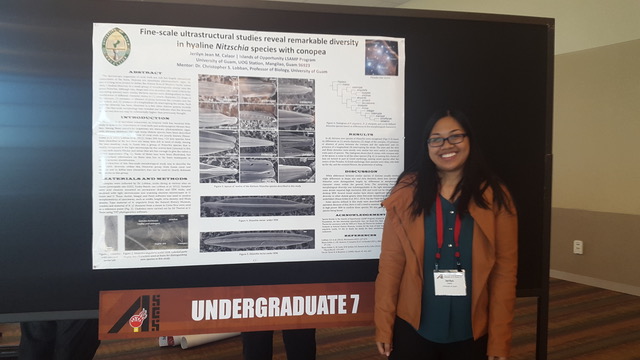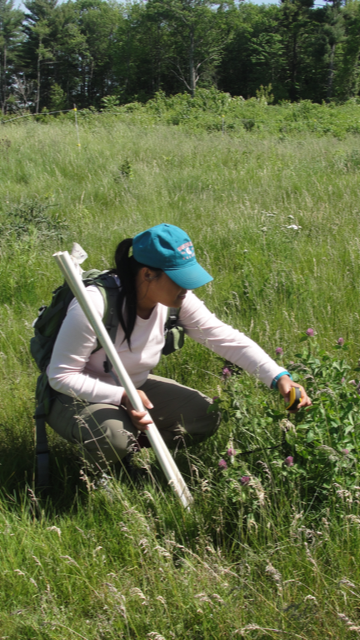Student Spotlight: Jerilyn Calaor
Biology Student Receives Prestigious National Science Foundation Award
Student Spotlight: Jerilyn Calaor
5/4/2018
Biology Student Receives Prestigious National Science Foundation Award

Jerilyn Calaor presents her poster at the 2015 AISES National Conference held in Phoenix, Arizona. The poster was of the diatom research conducted in Summer 2015 under the mentorship of Dr. Christopher Lobban.
Following a competitive application process, University of Guam biology major Jerilyn Calaor has been offered an award from the National Science Foundation's (NSF) Graduate Research Fellowship Program (GRFP).
Jerilyn is one of the 2000 awardees selected for the GRFP fellowship. More than 12,000 applicants from all 50 U.S. states, the District of Columbia and the U.S. territories applied for the program. According to the NSF, GRFP recruits high-potential, early-career scientists and engineers and supports their graduate research training in science, technology, engineering and mathematics (STEM) fields.
Jerilyn will be graduating from UOG with a Bachelor of Science in Biology, Minor in Chemistry in the 2018 Fañomnåkan (Spring) semester.
“I have always taken an interest in environmental studies and research. Coming here to UOG and majoring in Biology, my focus has always been in environmental research,” she said.
Through the GRFP fellowship, she will pursue her doctoral degree in the Ecology and Evolutionary Biology Program at Iowa State University (ISU) during the 2018 Fanuchånan semester.
While nothing is set in stone, Jerilyn hopes to conduct research related to invasive species as part of her doctoral studies. With their strong ecology and evolutionary biology curriculum, she said ISU would help her achieve this goal. She said choosing ISU would also enable her to collaborate with Dr. Haldre S. Rogers, a conservation biologist, who is known for her invasive species research on Guam.
|
|
|
|
Jerilyn Calaor conducts field research as part of Harvard University’s Forest Summer Research in Ecology Program (REU). |
Building a Career in Ecology
As a UOG student, Jerilyn built up her resume during school breaks by applying for research and fellowship programs. She said this prepared her for her doctoral studies.
UOG: A Competitive Force
According to NSF, the GRFP fellowship provides three years of financial support within a five-year fellowship period -- $34,000 annual stipend and $12,000 cost-of-education allowance to the graduate institution. That support is for graduate study that leads to a research-based master's or doctoral degree in a STEM field.
The GRFP program was launched in 1952. The program represents the nation's oldest continuous investment in the U.S. STEM workforce, according to NSF. Former fellows make transformative breakthroughs in STEM, are leaders in their chosen careers, and have been honored as Nobel laureates.
The GRFP program, according to NSF, contributes to increasing the diversity of the STEM workforce, including geographic distribution, as well as the participation of women, underrepresented minorities, persons with disabilities and veterans.
According to NSF, this year's awardees include 1,156 women, 461 individuals from underrepresented minority groups, 75 persons with disabilities, 27 veterans and 780 who have not yet enrolled in graduate school.
While the fellowship application process is competitive, students from Guam should not be deterred from submitting their application, according to Jerilyn. “Do not be afraid to apply. We are as competitive as everybody else out there,” she said.
After completing her doctoral program, Jerilyn hopes to come back to Guam to conduct meaningful research and to mentor a younger generation of ecologists.
“One day, hopefully, I would be able to become a professor here -- to kind of give back and be a mentor figure. Much like the professors here have inspired me to go into this, I’d like to be that to someone,” she said.

